Andrzej Matynia
Polish painting scene has always varied and been open to external inspiration. Sometimes, although not often, it imposed its point of view. Unfortunately, Polish signals were received by the world audience with delay for many reasons. When in June 1983 Ryszard Stanislawski – invaluable popularizer of Polish art – exhibited Witkacy, Schultz and Polish constructivists at the Pompidou Centre it was a promotion delayed at least by half a century (although it was not Stanislawski’s fault).
There is no exaggeration in the statement that Strzeminski and Kobro have recently reached the apogee of popularity in Germany, where constructivism is much more popular than in Poland. We were infatuated by the French impressionism for decades. That point of view was fixed by Jozef Pankiewicz, who established the Paris Committee in 1923. It was an organised group of young artists, who went to Paris to learn about new trends and then created a branch of Cracow Academy of Fine Arts on the Seine. Those young painters – quite surprisingly!? – did not get interested in cubism, which started to be a part of the mainstream, but in impressionism which was already passe for the French avant-garde. Pankiewicz had never changed his admiration for impressionist painters.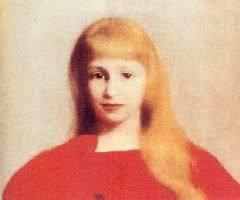 „All extra-painting manifestations, which occurred after Cezanne, are an admission of a failure to create a painting” – he declared with authority.
„All extra-painting manifestations, which occurred after Cezanne, are an admission of a failure to create a painting” – he declared with authority.
After the World War II Pankiewicz’s students, „Kapists” as they were called, took over all professorial positions at Polish art schools. They imposed their way of seeing art: the painting blotch. They professed after Maurice Denis, that „painting, before it becomes a battle horse, a nude woman, or any other anecdote, first of all is a flat surface covered with paint in a certain order”. It does not mean, however, that they were advocates of abstractionism. Jan Cybis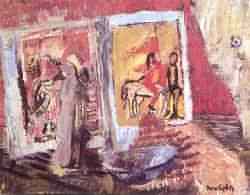 , Pankiewicz’s student, and professor of the Fine Arts Academy in Warsaw since 1945 wrote in his notes. „Bonnard had a slip of tongue, quoted incessantly, that abstraction will save the painting. At the moment the truth is quite to the contrary. Ten years from now nobody will be able to paint a rabbit. Some knowledge is dying out”. It was in 1960. Earlier, in the same „painter’s notes” he wrote: „Abstractionists must be the dumbest artists, at least in our country. I read their arguments – dead pan, convoluted and patronizing – with displeasure”. And further on „they do a lot of harm in spite of good will. They know nothing, everything must be called in some scholarly way, they are insensitive. I noticed the same with Strzeminski. Moreover how much they must suffer for their convictions. They are true martyrs of the kind who spend their whole life standing on one leg. The other withers in the meantime. It is better to walk on all fours. As a matter of fact our abstractionists are simply primitive stylists in the 19th century fashion”.
, Pankiewicz’s student, and professor of the Fine Arts Academy in Warsaw since 1945 wrote in his notes. „Bonnard had a slip of tongue, quoted incessantly, that abstraction will save the painting. At the moment the truth is quite to the contrary. Ten years from now nobody will be able to paint a rabbit. Some knowledge is dying out”. It was in 1960. Earlier, in the same „painter’s notes” he wrote: „Abstractionists must be the dumbest artists, at least in our country. I read their arguments – dead pan, convoluted and patronizing – with displeasure”. And further on „they do a lot of harm in spite of good will. They know nothing, everything must be called in some scholarly way, they are insensitive. I noticed the same with Strzeminski. Moreover how much they must suffer for their convictions. They are true martyrs of the kind who spend their whole life standing on one leg. The other withers in the meantime. It is better to walk on all fours. As a matter of fact our abstractionists are simply primitive stylists in the 19th century fashion”.
Cybis was not isolated in his views. Almost all „Kapists” thought that way. IVaturally „Kapists” did not overwhelm Polish post-war painting. Still active were Wladyslaw Strzeminski, as well as Henryk Stazewski closely connected with the pre-war European avant-garde and Andrzej Pronaszko fascinated with cubism.
 New artists, such as Tadeusz Kantor began to appear. They were saturated with new tendencies in art and transferred them to the Polish scene.
New artists, such as Tadeusz Kantor began to appear. They were saturated with new tendencies in art and transferred them to the Polish scene.
Avant-garde tendencies in Polish painting were not blocked by the decreed from above doctrine of socialist realism. The most distinguished Polish painters remained indifferent to its demagogic propaganda slogans. They shunned official institutions and found shelter in their studios. Even those, who were involved in the political left before the war, such as Maria Jarema.
The only truly tragic victim of the socrealist doctrine was Wladyslaw Strzeminski banned from the Academy, deprived of means of existence, illness-ridden, persecuted not only by the authorities…
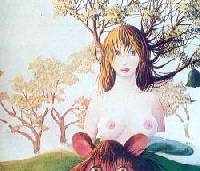
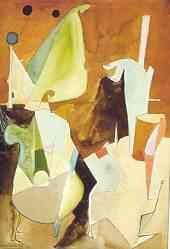 A new generation of painters entered the scene with pride, in spite of difficulties: Tadeusz Brzozowski and his grotesque figures distorted and in vivid colour, that soon would dominate his art; Kazimierz Mikulski and his fairy- tale world of beasts and people, Marian Bogusz – fascinated with music, Jerzy Nowosielski with his geometric tendencies and expressionist Jerzy Tchorzewski. Those young artists did not look for the solution of artistic quests in colour patterns but in multiple potential of drawing. Andrzej Wisniewski embodies that tendency to the fullest. Not only in the series „Executed” of 1949 but also in later gouache and monotypes.
A new generation of painters entered the scene with pride, in spite of difficulties: Tadeusz Brzozowski and his grotesque figures distorted and in vivid colour, that soon would dominate his art; Kazimierz Mikulski and his fairy- tale world of beasts and people, Marian Bogusz – fascinated with music, Jerzy Nowosielski with his geometric tendencies and expressionist Jerzy Tchorzewski. Those young artists did not look for the solution of artistic quests in colour patterns but in multiple potential of drawing. Andrzej Wisniewski embodies that tendency to the fullest. Not only in the series „Executed” of 1949 but also in later gouache and monotypes.
Each of those young artists would soon become a significant artistic individuality.
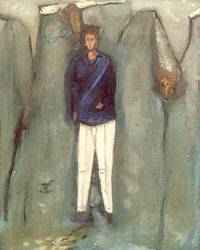 Jerzy Nowosielski would depart furthest from the ideals of youth. In his later paintings he would approach the icon idea established in the Byzantium and old-Russian tradition. Polish critics attach great importance to the All-Polish Exhibition of Young Art opened in July of 1955 and called after the place it was held at – the Arsenal. The exhibition in itself did not pose a breakthrough in Polish art, but it gave a start to a vivid debate in the press on the subject of realism in art. Abstract art had not been discussed yet, but the subject of deforming reality was heavily debated – up to the point of formulating extreme statements that art does not exist without distortion. Undoubtedly that was a reaction to the dogmatic attacks of socrealism advocates against cubist tendencies in Western Art. They propagated the nonsensical view that distortion in art is the result of having a human being in contempt.
Jerzy Nowosielski would depart furthest from the ideals of youth. In his later paintings he would approach the icon idea established in the Byzantium and old-Russian tradition. Polish critics attach great importance to the All-Polish Exhibition of Young Art opened in July of 1955 and called after the place it was held at – the Arsenal. The exhibition in itself did not pose a breakthrough in Polish art, but it gave a start to a vivid debate in the press on the subject of realism in art. Abstract art had not been discussed yet, but the subject of deforming reality was heavily debated – up to the point of formulating extreme statements that art does not exist without distortion. Undoubtedly that was a reaction to the dogmatic attacks of socrealism advocates against cubist tendencies in Western Art. They propagated the nonsensical view that distortion in art is the result of having a human being in contempt.
In Polish art in the 1960s there occurred a general rejection of realism. Polish artists kept a keen eye not only on Paris but more and more willingly on New York. Soon after the influence of Rothko, Pollock and de Kooning became more evident on the Polish scene. New personalities appeared in Polish painting: Tadeusz Dominik, Roman Artymowski, Stefan Gierowski; Aleksander Kobzdej would betray realism, while Kajetan Sosnowski, Jan Berdyszak and Ryszard Winiarski started experimenting with the form and matter of painting. No longer only the colour but also the form and texture of the painting became important for the artistic expression.
In Polish painting public service dimension is as important as colorism is. In my opinon, the former is attempting to deal with the wide sphere of human activity, its historic, social and political aspects as well as the human being as such. Undoubtedly that phenomenon (both characteristic and specific for Polish art) orginates in the l9th century, when Poland was not an independent state. Painters took on a difficult role of supporting and encouraging the nation’s morale.
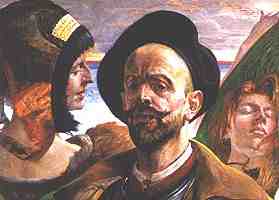 Jan Matejko recalled the moments of greatness in Polish history. Henryk Siemiradzki used the Aesopic language to persuade the public that each empire finds its end and the sacrifices are not going to waste (Nero’s Torches). The same sentiment was addressed by Jacek Malczewski who painted political prisoners in their exile to Siberia.
Jan Matejko recalled the moments of greatness in Polish history. Henryk Siemiradzki used the Aesopic language to persuade the public that each empire finds its end and the sacrifices are not going to waste (Nero’s Torches). The same sentiment was addressed by Jacek Malczewski who painted political prisoners in their exile to Siberia.
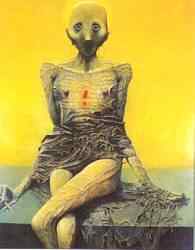 Naturally socrealist paintings should be placed in the same sphere. They had many supporters not only among the authorities. Many painters made a spontaneous bid to present the work ethos. Many were actually quite successful in their ventures. It is sufficient to recall the painting by Aleksander Kobzdej „Pass the brick” or the portrait of a tractor driver by Henryk Stazewski. The painting’s of Andrzej Wroblewski belonged to the same trend. Wroblewski’s deeply believed in the lofty (and even demagogic) slogans of the socialist realism but in his artistic practice, fortunately, he was not able to meet their requirements (unfortunate distortion).
Naturally socrealist paintings should be placed in the same sphere. They had many supporters not only among the authorities. Many painters made a spontaneous bid to present the work ethos. Many were actually quite successful in their ventures. It is sufficient to recall the painting by Aleksander Kobzdej „Pass the brick” or the portrait of a tractor driver by Henryk Stazewski. The painting’s of Andrzej Wroblewski belonged to the same trend. Wroblewski’s deeply believed in the lofty (and even demagogic) slogans of the socialist realism but in his artistic practice, fortunately, he was not able to meet their requirements (unfortunate distortion).
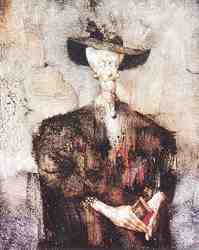 The sudden outburst of publicist tendencies took place in the 1970s and later on in martial law period (not always producing the greatest works). The 1970s had a paradoxical influence on some artists. The so called „Gierek era „was generally considered to be a period of stability, relative welfare and opening to the West, yet it was then that Jerzy Duda-Gracz painted an ironical picture entitled „Workers and Peasants Alliance” in which a peasant and a worker drink coca-cola with spoons from a common bowl at the foot of the cathedral.
The sudden outburst of publicist tendencies took place in the 1970s and later on in martial law period (not always producing the greatest works). The 1970s had a paradoxical influence on some artists. The so called „Gierek era „was generally considered to be a period of stability, relative welfare and opening to the West, yet it was then that Jerzy Duda-Gracz painted an ironical picture entitled „Workers and Peasants Alliance” in which a peasant and a worker drink coca-cola with spoons from a common bowl at the foot of the cathedral.
Even earlier, in 1966 the „Wprost” (In the face) group had begun to deal with social issues. Zbylut Grzywacz showed individuals degraded by politics, social relations and their own desire to get rid of their backbones or dignity. He was accompanied by Leszek Sobocki and Maciej Bieniasz from the same group. However, the most uncompromising, brutal and poignant revelation of human hypocrisy and insincerity was created by Jerzy Duda-Gracz. Surprisingly, the society received its own portrait with masochistic ecstasy!
That critical group was joined by Edward Dwurnik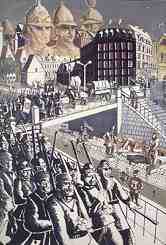 some time later. Like the former ones, he diagnosed the decline of society as a result of the degradation of the individual. Wroblewski painted a picture „The queue keeps on „. Zbylut Grzywacz dedicated to his great predecessor a painting under a slightly different title „The queue still keeps on „. There are a mother with child, a man and an old woman sitting in the chairs, waiting, while a red arrow, thicker than at Wroblewski’s painting indicated the direction of the line.That apparently stable and permanent socio-political set-up collapsed one day like a house of cards. What was the role our writers, film makers and painters had in shaping the social consciousness is hard to say. Nevertheless they drilled the rock with minute but sobering activities. Martial law made a number of outstanding artists go underground (mostly ecclesiastical) and also spurred a group of emotionally aware youth to join them.
some time later. Like the former ones, he diagnosed the decline of society as a result of the degradation of the individual. Wroblewski painted a picture „The queue keeps on „. Zbylut Grzywacz dedicated to his great predecessor a painting under a slightly different title „The queue still keeps on „. There are a mother with child, a man and an old woman sitting in the chairs, waiting, while a red arrow, thicker than at Wroblewski’s painting indicated the direction of the line.That apparently stable and permanent socio-political set-up collapsed one day like a house of cards. What was the role our writers, film makers and painters had in shaping the social consciousness is hard to say. Nevertheless they drilled the rock with minute but sobering activities. Martial law made a number of outstanding artists go underground (mostly ecclesiastical) and also spurred a group of emotionally aware youth to join them.
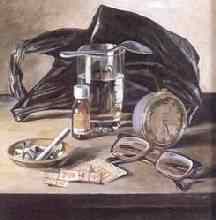 Did they produce great works of art? The answer was not unequivocal. Sometimes good intentions had to make up for artistic skills. Undoubtedly Zbylut Grzywacz, Sobocki, Lukasz Korolkiewicz found their place. Next to them stood the young artists, whose work was formally related to expressionism, such as Ryszard Wozniak, Ryszard Grzyb, Marek Sobczyk, Pawel Jarodzki, Jaroslaw Modzelewski. This way they took a position next to the „Neue Wilde”.
Did they produce great works of art? The answer was not unequivocal. Sometimes good intentions had to make up for artistic skills. Undoubtedly Zbylut Grzywacz, Sobocki, Lukasz Korolkiewicz found their place. Next to them stood the young artists, whose work was formally related to expressionism, such as Ryszard Wozniak, Ryszard Grzyb, Marek Sobczyk, Pawel Jarodzki, Jaroslaw Modzelewski. This way they took a position next to the „Neue Wilde”.
However, the obligatory boycott of the official exhibitions and refusal to participate in the international exhibitions removed that group of Polish artists from the world’s scrutiny.
Expressionism was not popular with Polish artists. Few of them may be attributed to have expressionist leanings. Some critics believe Witkacy was one of them. Their arguments are convincing. Nevertheless, young Polish artists declared access to the trend in greater numbers only in the 1980s. Not only the ones mentioned earlier but also Henryk Czesnik, Zdzislaw Nitka, Aleksander Roszkowski, Krzsztof Skarbek, Anna Ziaja. Everyone did it in a different way. All of them, however, adopted as their topic the human condition in the modern world.
was one of them. Their arguments are convincing. Nevertheless, young Polish artists declared access to the trend in greater numbers only in the 1980s. Not only the ones mentioned earlier but also Henryk Czesnik, Zdzislaw Nitka, Aleksander Roszkowski, Krzsztof Skarbek, Anna Ziaja. Everyone did it in a different way. All of them, however, adopted as their topic the human condition in the modern world.
Henryk Czesnik approached this issue in the most perceptive way. Czesnik’s expression is sophisticated, existential but ontological. Nitka and Skarbek use colour in the poster fashion, Skarbek however is also ostentatious with his reference to naive art. Roszkowski, on the other hand, as a true postmodernist quotes the old masters, starting with Grunewald, in his paintings. It is a pity that those young artists appeared on the world stage with some delay. The world, contrary to common view, is not sentimental and does not listen to on, even the most noble justifications. Contemporary art (alas!) prioritises those who appear first, or are significtly different.
 That fact might be responsible for the recognition the art of Tomasz Ciecierski and Leon Tarasewicz won abroad. They are true enclaves of difference in the Polish artistic scene. Expressionism alike, few Polish painters were attracted to grotesque. Although grotesque is considered the form of expression characteristic of our times , only a few Polish artists use this form as their own. Undoubtedly Witold Wojtkiewcz made up a group together with Tadeusz Makowski and Witkacy, that occasionally applied it. Tadeusz Brzozowski applied it in a very subtle and intellectually sophisticated way. Eugeniusz Markowski, Jerzy Duda-Gracz and Andrzej Umiastowski are much more brutal in their application of the form. Markowski’s paintings are the fighting arena for grotesque male figures. They show their unnaturally large, white teeth in an angry snarl, they expose their massive muscles and huge butts and feet. They fight brutally. They kick each other in the groins, stick the spears in the rectum, while the defeated ones are severely humiliated. Similarly grotesque are men and women in Duda-Gracz’s paintings. However, his protagonists do not fight but perform ceremonies, rituals and pilgrimages, and their external deformity reveals their inner emptiness and ethical hideousness.
That fact might be responsible for the recognition the art of Tomasz Ciecierski and Leon Tarasewicz won abroad. They are true enclaves of difference in the Polish artistic scene. Expressionism alike, few Polish painters were attracted to grotesque. Although grotesque is considered the form of expression characteristic of our times , only a few Polish artists use this form as their own. Undoubtedly Witold Wojtkiewcz made up a group together with Tadeusz Makowski and Witkacy, that occasionally applied it. Tadeusz Brzozowski applied it in a very subtle and intellectually sophisticated way. Eugeniusz Markowski, Jerzy Duda-Gracz and Andrzej Umiastowski are much more brutal in their application of the form. Markowski’s paintings are the fighting arena for grotesque male figures. They show their unnaturally large, white teeth in an angry snarl, they expose their massive muscles and huge butts and feet. They fight brutally. They kick each other in the groins, stick the spears in the rectum, while the defeated ones are severely humiliated. Similarly grotesque are men and women in Duda-Gracz’s paintings. However, his protagonists do not fight but perform ceremonies, rituals and pilgrimages, and their external deformity reveals their inner emptiness and ethical hideousness.
Umiastowski, in his own way, presents a sad, nostalgic harlequinade. In a shoddy overcoat, red-nosed due to drinking, in shabby trousers and colourless a hero of Umiastowski’s wanders through the Polish landscape. Sometimes the characters succumb to trifle pastime as if confirming king Stefan Batory’s opinion that „Poles are a fickle folk, in spite of bravery, they don’t have endurance, prefer play to work, and do not value life”.
In the last years Polish painting displayed a comeback of the narrative. „Don’take heed of the abstractionists, tell the story. But don’t tell it as a fool” Jan Cybis taught his students. It seems that the young are telling sensible stories. In different ways and on different matters.
In the 1920s Russian avant-garde artists thought that the society was undergoing changes, and that a new society would need new art. It was an illusion. It turned out that people prefer clear and comprehensible stories. Sometimes, primitive ones, that is the ones, that Pop-Artists offered them. Moreover people are extremely attached to traditional forms of communication.
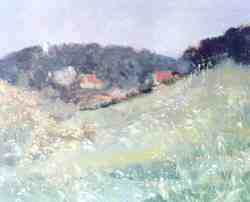 Polish artists can exceed the limits of good taste, and try to shock with obscene pictures, they offend religious feelings, and abuse eroticism (Zagalski, Naliwajko, Szpyt). But the audience is tired of extravagance, they watch it but Jerzy Gnatowski for the home they purchase paintings perfectly executed. Landscapes painted scrupulously. Pankiewicz wrote that „the Polish landscape ought to be painted while it is raining. The sun here is weak, and cool; it does not cherish colour”. However, the landscapes of Kazimierz by Andrzej Kolodziejczyk and Jerzy Gnatowski „resound” even if Gnatowski dampens the glare with glaze.
Polish artists can exceed the limits of good taste, and try to shock with obscene pictures, they offend religious feelings, and abuse eroticism (Zagalski, Naliwajko, Szpyt). But the audience is tired of extravagance, they watch it but Jerzy Gnatowski for the home they purchase paintings perfectly executed. Landscapes painted scrupulously. Pankiewicz wrote that „the Polish landscape ought to be painted while it is raining. The sun here is weak, and cool; it does not cherish colour”. However, the landscapes of Kazimierz by Andrzej Kolodziejczyk and Jerzy Gnatowski „resound” even if Gnatowski dampens the glare with glaze.
Translated by Marek Szopski
Darmowe gry hazardowe oferowane są dziś przez praktycznie wszystkie legalne kasyna z licencją. Powód takiej polityki jest bardzo prosty: przed postawieniem prawdziwych pieniędzy możemy przetestować konkretny automat. Taką politykę mają dziś między innymi istniejące od wielu lat na polskim rynku kasyna takie jak kasyno na pieniądze Sportaza Casino czy nowe kasyno online Casiqo Casino. Jak gracz może skorzystać z darmowych automatów jednoręki bandyta? Wystarczy przejść do strony kasyna i wyszukać ulubioną grę. W polu wyszukiwania w lobby głównym wpisujemy nazwę slota – na przykład slot Crazy Monkey od Belatra – i uruchamiamy grę bez rejestracji i bez wpłaty depozytu. Gdy opanujemy już zasady gry i nauczymy się zarządzać budżetem, możemy później uruchomić grę i postawić w niej prawdziwe pieniądze. Gra za kasę oznacza oczywiście dodatkowe ryzyko, ale plus gry jest jeden: przy uzyskaniu jackpota będziemy mogli go po prostu wypłacić na konto! Takiej opcji nie oferują darmowe gry w kasynach.